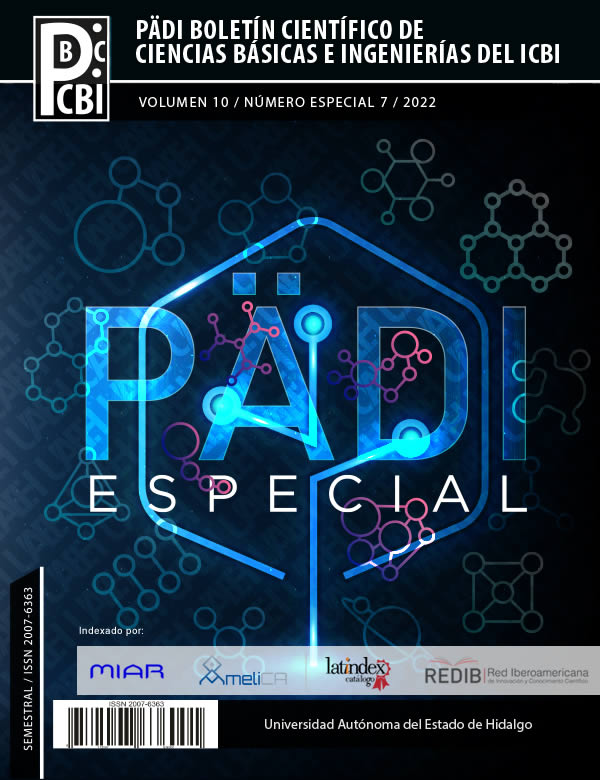Evaluación de la citotoxicidad de fosfatos de calcio sintetizados a diferentes relaciones molares de Ca/P por la vía hidrotermal
DOI:
https://doi.org/10.29057/icbi.v10iEspecial7.9957Palabras clave:
hidroxiapatita, hidrotermal, citotoxicidadResumen
En el presente estudio, se sintetizaron polvos de fosfato de calcio vía hidrotermal con relaciones molares Ca/P de 1.4, 1.67 y 2.0. La cristalinidad y fase se determinaron mediante análisis de difracción de rayos X, la formación de los fosfatos de calcio se evidenció mediante la espectrofotometría de infrarrojo. La estabilidad térmica medida por análisis termogravimétrico demostró que la muestra con relación molar Ca/P: 1.67 (Hidroxiapatita) es más estable. La morfología de los polvos se observó mediante microscopía electrónica de barrido. Los estudios de citotoxicidad con la línea celular NIH-3T3 de fibroblastos de ratón en concentraciones de 10 mg/ml, indicaron que los polvos obtenidos con diferentes relaciones Ca/P son citocompatibles.
Descargas
Información de Publicación
Perfiles de revisores N/D
Declaraciones del autor
Indexado en
- Sociedad académica
- N/D
Citas
Auclair‐Daigle, C., Bureau, M. N., Legoux, J. G., & Yahia, L. H. (2005). Bioactive hydroxyapatite coatings on polymer composites for orthopedic implants. Journal of Biomedical Materials Research Part A: An Official Journal of The Society for Biomaterials, The Japanese Society for Biomaterials, and The Australian Society for Biomaterials and the Korean Society for Biomaterials, 73(4), 398-408.
Boanini, E., Fini, M., Gazzano, M., & Bigi, A. (2006). Hydroxyapatite nanocrystals modified with acidic amino acids.
Habibovic, P., Barrere, F., Van Blitterswijk, C. A., de Groot, K., & Layrolle, P. (2002). Biomimetic hydroxyapatite coating on metal implants. Journal of the American Ceramic Society, 85(3), 517-522.
Kundu, B., Lemos, A., Soundrapandian, C., Sen, P. S., Datta, S., Ferreira, J. M. F., & Basu, D. (2010). Development of porous HAp and β-TCP scaffolds by starch consolidation with foaming method and drug-chitosan bilayered scaffold based drug delivery system. Journal of Materials Science: Materials in Medicine, 21(11), 2955-2969.
Lahiri, D., Benaduce, A. P., Rouzaud, F., Solomon, J., Keshri, A. K., Kos, L., & Agarwal, A. (2011). Wear behavior and in vitro cytotoxicity of wear debris generated from hydroxyapatite–carbon nanotube composite coating. Journal of Biomedical Materials Research Part A, 96(1), 1-12.
Liu, H., Yazici, H., Ergun, C., Webster, T. J., & Bermek, H. (2008). An in vitro evaluation of the Ca/P ratio for the cytocompatibility of nano-to-micron particulate calcium phosphates for bone regeneration. Acta biomaterialia, 4(5), 1472-1479.
Ozawa, M., & Suzuki, S. (2002). Microstructural development of natural hydroxyapatite originated from fish‐bone waste through heat treatment. Journal of the American Ceramic Society, 85(5), 1315-1317.
Malhotra, A., & Habibovic, P. (2016). Calcium phosphates and angiogenesis: implications and advances for bone regeneration. Trends in biotechnology, 34(12), 983-992.
Mobasherpour, I., Heshajin, M. S., Kazemzadeh, A., & Zakeri, M. (2007). Synthesis of nanocrystalline hydroxyapatite by using precipitation method. Journal of Alloys and Compounds, 430(1-2), 330-333.
Mondal, S., Bardhan, R., Mondal, B., Dey, A., Mukhopadhyay, S. S., Roy, S. & Roy, K. (2012). Synthesis, characterization and in vitro cytotoxicity assessment of hydroxyapatite from different bioresources for tissue engineering application. Bulletin of materials science, 35(4), 683-691.
Motskin, M., Wright, D. M., Muller, K., Kyle, N., Gard, T. G., Porter, A. E., & Skepper, J. N. (2009). Hydroxyapatite nano and microparticles: correlation of particle properties with cytotoxicity and biostability. Biomaterials, 30(19), 3307-3317.
Ozawa, M., & Suzuki, S. (2002). Microstructural development of natural hydroxyapatite originated from fish‐bone waste through heat treatment. Journal of the American Ceramic Society, 85(5), 1315-1317.
Prakash Parthiban, S., Elayaraja, K., Girija, E. K., Yokogawa, Y., Kesavamoorthy, R., Palanichamy, M. & Narayana Kalkura, S. (2009). Preparation of thermally stable nanocrystalline hydroxyapatite by hydrothermal method. Journal of Materials Science: Materials in Medicine, 20(1), 77-83.
Prakasam, M., Locs, J., Salma-Ancane, K., Loca, D., Largeteau, A., & Berzina-Cimdina, L. (2017). Biodegradable materials and metallic implants—a review. Journal of functional biomaterials, 8(4), 44.
Predoi, D., Iconaru, S. L., Predoi, M. V., Motelica-Heino, M., Guegan, R., & Buton, N. (2019). Evaluation of antibacterial activity of zinc-doped hydroxyapatite colloids and dispersion stability using ultrasounds. Nanomaterials, 9(4), 515.
Rocha, J. H. G., Lemos, A. F., Kannan, S., Agathopoulos, S., & Ferreira, J. M. F. (2005). Hydroxyapatite scaffolds hydrothermally grown from aragonitic cuttlefish bones. Journal of Materials Chemistry, 15(47), 5007-5011.
Roy, M., Fielding, G. A., Beyenal, H., Bandyopadhyay, A., & Bose, S. (2012). Mechanical, in vitro antimicrobial, and biological properties of plasma-sprayed silver-doped hydroxyapatite coating. ACS applied materials & interfaces, 4(3), 1341-1349.
Sariibrahimoglu, K., Wolke, J. G., Leeuwenburgh, S. C., Yubao, L., & Jansen, J. A. (2014). Injectable biphasic calcium phosphate cements as a potential bone substitute. Journal of Biomedical Materials Research Part B: Applied Biomaterials, 102(3), 415-422.
Wei, Y., Chang, Y. H., Liu, C. J., & Chung, R. J. (2018). Integrated oxidized-hyaluronic acid/collagen hydrogel with β-TCP using proanthocyanidins as a crosslinker for drug delivery. Pharmaceutics, 10(2), 37.




















